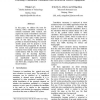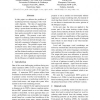ACL
2012
12 years 6 months ago
2012
In this paper, we address the issue for learning better translation consensus in machine translation (MT) research, and explore the search of translation consensus from similar, r...
EMNLP
2011
13 years 3 months ago
2011
We present an online learning algorithm for training parsers which allows for the inclusion of multiple objective functions. The primary example is the extension of a standard sup...
ICASSP
2011
IEEE
13 years 7 months ago
2011
IEEE
Enriching a pronunciation dictionary with phonological variation is a challenging task, not yet solved despite several decades of research, in particular for speech-to-text transc...
ICASSP
2011
IEEE
13 years 7 months ago
2011
IEEE
This paper provides an analysis of the impacts of machine translation and speech synthesis on speech-to-speech translation systems. The speech-to-speech translation system consist...
ICASSP
2011
IEEE
13 years 7 months ago
2011
IEEE
In this paper, several approaches for language portability of dialogue systems are investigated with a focus on the spoken language understanding (SLU) component. We show that the...
IALP
2010
13 years 10 months ago
2010
Target phrase selection, a crucial component of the state-of-the-art phrase-based statistical machine translation (PBSMT) model, plays a key role in generating accurate translation...
JMLR
2011
13 years 10 months ago
2011
We propose a distance phrase reordering model (DPR) for statistical machine translation (SMT), where the aim is to learn the grammatical rules and context dependent changes using ...
CSL
2011
Springer
13 years 10 months ago
2011
Springer
In this paper we address the problem of translating between languages with word order disparity. The idea of augmenting statistical machine translation (SMT) by using a syntax-bas...
COLING
2010
13 years 10 months ago
2010
An unsupervised discriminative training procedure is proposed for estimating a language model (LM) for machine translation (MT). An English-to-English synchronous context-free gra...
COLING
2010
13 years 10 months ago
2010
This paper proposes a new approach to phrase rescoring for statistical machine translation (SMT). A set of novel features capturing the translingual equivalence between a source a...


